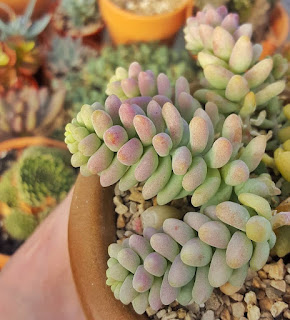Sedum Morganianum: How to take care of your Donkey Tail succulent
Donkey Tail succulents, also known as Sedum Morganianum or Burro's Tail, are charming and easy-to-care-for plants with trailing stems covered in plump, teardrop-shaped leaves. To keep your Donkey Tail succulent healthy and thriving, follow these easy and informative care guidelines.
If you would like to own a hanging Donkey tail succulent you can buy one here.
Light:
- Donkey Tail succulents prefer bright, indirect sunlight. A few hours of direct morning sunlight is beneficial, but intense afternoon sun can scorch their delicate leaves.
- If you're growing your succulent indoors, place it near a south or west-facing window.
Soil:
- Use a well-draining succulent or cactus mix. You can also add perlite or sand to improve drainage.
- Ensure the pot has drainage holes to prevent water from pooling at the bottom.
Watering:
- Allow the soil to dry out completely between waterings. Overwatering is a common issue with succulents and can lead to root rot.
- Water thoroughly when the top inch of the soil is dry, and let excess water drain away.
- Reduce watering during the winter months when the plant is in a dormant phase.
- If you are unsure on when to water your succulent you can use a moisture meter to take away the guesswork.
Temperature:
- Donkey Tails thrive in warm temperatures. They can tolerate a range of temperatures but prefer temperatures between 60-75°F (15-24°C).
- Protect the plant from frost, as they are sensitive to cold temperatures.
Humidity:
- Donkey Tails are adapted to arid conditions and prefer low humidity. Ensure good air circulation around the plant.
Fertilizing:
- Feed your Donkey Tail with a balanced, water-soluble fertilizer diluted to half strength during the growing season (spring and summer).
- Avoid fertilizing during the dormant season (fall and winter).
Pruning:
- Trim leggy or damaged stems to encourage bushier growth. Use clean, sharp scissors or pruning shears.
- You can propagate new plants from the trimmed stems. Allow the cut ends to callus for a day or two before planting them in soil.
Pests:
- Keep an eye out for common succulent pests like mealybugs and spider mites. Treat infestations promptly with insecticidal soap or neem oil. If your plant is indoors you can use a systemic bug killer, these are bad for bees though so best kept indoors.
Container Size:
- Donkey Tails do well in slightly snug containers. Repot when the plant outgrows its current pot, typically every 2-3 years in the spring.
- Donkey tails can shed leaves easily when moved or touched so are best kept hanging out of the way, use a hanging planter with a drip tray to avoid any messes when watering. If your donkey tail is already in the perfect pot you can use a macrame plant hanger to hang it in your favorite spot.
If you don't own one of these magnificent succulents but would like to add one to your collection you can buy one here.
By following these guidelines, you'll be well on your way to cultivating a healthy and happy Donkey Tail succulent. Enjoy the unique charm and resilience of this lovely plant!

.png)





